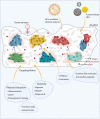We Are One: Multispecies Metabolism of a Biofilm Consortium and Their Treatment Strategies
- PMID: 33584635
- PMCID: PMC7876221
- DOI: 10.3389/fmicb.2021.635432
We Are One: Multispecies Metabolism of a Biofilm Consortium and Their Treatment Strategies
Abstract
The ecological and medical significance of bacterial biofilms have been well recognized. Biofilms are harder to control than their planktonic free-living counterparts and quite recently, the focus of the study has shifted to the multispecies consortia, which represent the vast majority of real-case infection scenarios. Studies have begun to explore the complex interspecies interactions within these biofilms. However, only little attention is currently given to the role of cellular metabolites in the cell-to-cell communication. The concentration gradients of metabolic substrates and products affect the spatial growth of bacteria in multispecies biofilm. This, if looked into more deeply, can lead to identification of potential therapies targeting the specific metabolites and hence the coordinated protection in the bacterial community. Herein, we review the interspecies communications, including their metabolic cross-talking, in multispecies biofilm, to signify the importance of such interactions on the initial formation and subsequent growth of these biofilms. Multispecies biofilms with their species heterogeneity are more resilient to antimicrobial agents than their single species biofilm counterparts and this characteristic is of particular interest when dealing with pathogenic bacteria. In this Review, we also discuss the treatment options available, to include current and emerging avenues to combat pathogenic multispecies biofilms in the clinical, environmental, as well as industrial settings.
Keywords: biofilms; interactions; metabolism; multispecies; treatment.
Copyright © 2021 Joshi, Gunawan and Mann.
Conflict of interest statement
The authors declare that the research was conducted in the absence of any commercial or financial relationships that could be construed as a potential conflict of interest.
Figures

References
-
- Blehert D. S., Palmer R. J., Xavier J. B., Almeida J. S., Kolenbrander P. E. (2003). Autoinducer 2 production by Streptococcusgordonii DL1 and the biofilm phenotype of a luxS mutant are influenced by nutritional conditions. J. Bacteriol. 185 4851–4860. 10.1128/JB.185.16.4851-4860.2003 - DOI - PMC - PubMed
Publication types
LinkOut - more resources
Full Text Sources
Other Literature Sources

